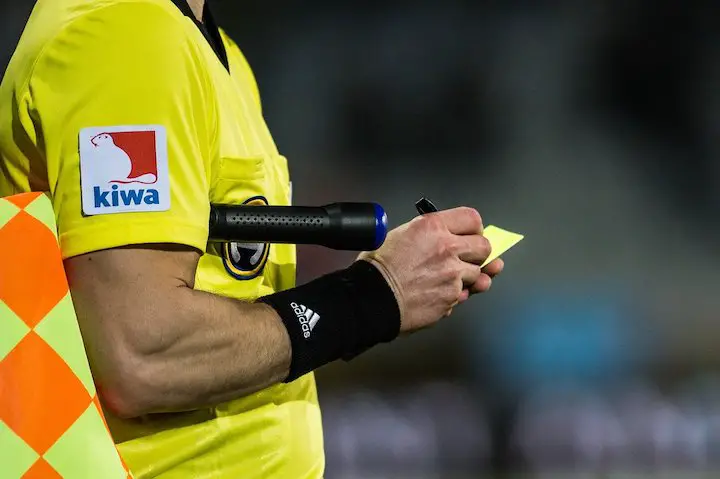Your Guide
 Alex Waite
Alex Waite
During a soccer match, you may see the referee reach into their pocket and thrust a YELLOW CARD in the air in the direction of a player.
This often follows a bad tackle, a player arguing with the referee or when someone tries to waste time to take pressure off their team.

When the referee shows a player a yellow card, also known as a booking, it is a warning from the referee.
They are showing, with their actions, that the player or manager in question, is on their final warning for breaking the rules of a soccer match.
At face value, the yellow card may be a warning sign. However, it has a deeper meaning.
There are many offenses where a player, manager, coach, physio or anyone involved with either team could receive a yellow card in soccer.
Furthermore, when a referee brandishes a yellow card, it is often the source of much debate among soccer fans.
Should it have been a red card instead?
Was it a harsh booking?
Did the referee make a mistake?
Below, we take a look at what the yellow card means in soccer and consider its implications.
We also highlight some of the most serial yellow card offenders who have received the most yellow cards in soccer history.
Yellow Card Offences
There are several reasons why someone would receive a yellow card in soccer.
The exact rules are defined by the International Football Association Board Laws of the Game, and they are updated before each season.
Law 12 – ‘Fouls and Misconduct’ – covers all the actions when someone could receive a yellow card.
Overall, 29 offenses exist for a yellow card, and these are organized into three main categories (fouls, misconduct and unsporting behavior).
Before the 2019/20 season, the rules were altered to include offenses relating to the Video Assistant Referee (VAR) in the leagues where it was used. Premier League, Bundesliga, La Liga and Serie A rules were changed to include VAR offenses.
These involve players trying to interfere with a referee’s decision or looking at the monitor when the referee is viewing an incident.
Below are the most common yellow card offenses in soccer:
- · A reckless tackle that could cause an injury.
- · Depriving an opponent of a scoring chance by breaking up an attack.
- · Preventing a player from getting to the ball by holding or shirt-tugging.
- · Preventing an attack by handling the ball.
- · Attempting to score by handling the ball.
- · Trying to influence the referee with a feigned injury to punish an opponent.
- · Showing dissent by a comment or action.
- · A reckless tackle that could cause an injury.
- · Depriving an opponent of a scoring chance by breaking up an attack.
- · Preventing a player from getting to the ball by holding or shirt-tugging.
- · Preventing an attack by handling the ball.
- · Attempting to score by handling the ball.
- · Trying to influence the referee with a feigned injury to punish an opponent.
- · Pretending to be injured by a foul to fool the referee.
While most yellow cards are shown during the 90 minutes of a soccer match, referees can also book or send off players after the final whistle.
Implications of a Yellow Card
There are short-term and long-term implications for receiving a yellow card.
If a player is booked twice in a match, they are sent off, meaning they have to leave the pitch, and their team is reduced from 11 to 10 players.
Longer-term, if a player is sent off for two yellow cards, they usually miss the next fixture, as long as it’s in the same competition.
Players are also banned if they accumulate enough yellow cards during a tournament or league season.
For example, players in the Premier League are banned for one match if they receive five bookings in a season.
If the same player receives 10 bookings in a season, they miss two fixtures.
Backroom staff, such as managers, coaches and physios, can also be sent off during a match.
In the 2020/21 season, Ranger’s manager, Steve Gerrard, was given two yellow cards for dissent by comment or action towards the referee. Subsequently, he was banned for Rangers’ next match against fierce rivals Celtic.
What Do Traffic Lights and Yellow Cards Have in Common?
Today, yellow and red cards in soccer are part of the fabric of the game. Rarely does a game pass without at least one yellow card shown.
However, this was not always the case. Before red and yellow cards were first used in the 1970 World Cup, referees did not have the option to brandish either card.
Discipline in soccer was a problem decades ago, and former English referee Ken Aston was central to regaining control of the soccer field.
Aston officiated the 1962 World Cup match between Chile and Italy, known as the Battle of Santiago, due to the violence between players during the encounter.
Two Italian players were sent off during the match, and both offenders, Giorgio Ferrini and Mario David struggled to understand Aston’s demands for them to leave the field of play.
The players protested so vociferously that the police had to escort the players off the pitch.
The difficulty with discipline continued in top-level soccer, and violence rose again in the 1966 World Cup, where Aston was appointed Head of Refereeing.
Baffled about how to regain control of the escalating ill-discipline in the game, inspiration eventually struck Aston as he drove around London one day.
He saw the traffic lights change from yellow to red and recognized that the ‘get ready to stop’ and ‘stop’ signals could be used in refereeing.
Aston pitched his idea to FIFA, and yellow and red cards were first used by referees at the Mexico World Cup in 1970.
It was a simple idea that changed the way players behaved and how referees became seen as central figures of the game.
Bad Boys: The Most Booked Players in History
Yellow cards have become common in modern soccer, with more and more rules introduced each season. But some players have gone above and beyond in their quest to get booked throughout their careers.
Below are the professional soccer players who have received the most yellow cards in soccer history. It may be no surprise that most are defenders or midfielders, prone to tackle more than others.
1. Sergio Ramos – 263
2. Gerardo Torrado – 228
3. Dani Alves – 210
4. Xabi Alonso – 197
5. Daniele Conti – 190
Conclusion
It is hard to imagine a time when soccer was played without the yellow card. Born out of a violent backdrop in the sport, the traffic light system invented by Ken Aston CHANGED THE SPORT FOREVER.
There are still some instances where players, fans, coaches etc will contest a booking for being harsh or ill-timed.
However, when a yellow card is shown in soccer, it is almost universally accepted as part of the modern game.
Without the yellow card, soccer matches have the potential to descend into chaos, as witnessed in Ashton’s unenviable task of officiating the 1962 match between Chile and Italy.
Soccer rules revolve around yellow and red cards, with minor tweaks and changes made each year, aiming to improve the quality of behavior and standard of soccer across the board.



